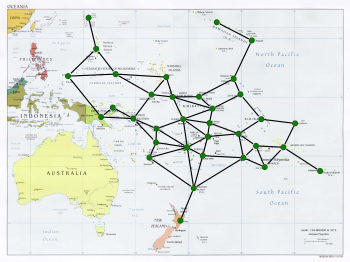Two types of resources across N colours. 3:1 ratio across types. N is in the 4-6 range. ~15 more common resources of each colour (~5 of the less common).
Resources are distributed across the islands. Possible all of them, more likely a subset with more coming out later. Most likely more come out as routes are built to islands.
Type #1 resources (big) are demands and are less common. Type #2 (small) are supplies and are three times as common. Demands want to meet their suppies in a 3:1 ratio, at which point they mutually annihilate (kept by players as VPs?).
Demands and supplies may be moved over competitively built routes by players. When a supply coexists with a demand it may not be moved (or visa versa). Once a demand is satisfied (3:1) it is removed from the game.
Players have money and a number of explorers (initially 1). Players nominate routes to be built, one per explorer. They may then bid on who gets to build each route. Bids are money. Players may sell VPs for money. Players may bid on any number of VPs. Subsequent bids may only be equal or higher (or only higher?).
Player order is then ordered in descending bid amount. The route with the largest big goes first with the largest bidder having the option to build it. In the case of a tie on a single route the nominating player picks. In the case of a tie across routes it defaults to prior player order. Building is free but the nominating player receives the winning bid. A player may win and opt not to build. A player may build routes equal to the number of explorers they have.
A player may not build more routes than they have explorers. Once all the building is done (single pass through the routes), then each player may deliver a supply to a destination or visa versa. Player’s have an AoS-style? Links limit. They may pass on a delivery to grow Links or may buy a bigger Links for cash (first to a level most expensive, subsequent cheaper as it becomes more common?). Two rounds of deliveries. Only one pass tor grow Links. Players must deliver if they can (unless they pass to bump).
When making a delivery resources travel over built routes. Each player owning a route used gets $1 from the bank per route. The delivering player also gets money equal to the number of resources (not supplies) of that type present on the island after the delivery.
At the end of a delivery a player may make a gift of some multiple of $3 (limit $3 per target player?) to one of the players possessing a link connected to the destination island. In return the donating player receives 1 VP per $3. The receiving player receives only $2 of each $3, the other $1 is returned to the bank. This is a nod to Kula ring patterns. Such money can then NOT be spent on bids and may only be used for Kula?
At the end of their last delivery a player may buy an explorer for cash. A player may not have more than 2? Nominating a route with a second explorer costs cash?
Repeat for next turn, possibly inverting last turn’s player order? (They weren’t distracted by building/bidding much and so had first opportunity to explore).
Game ends when all demands of N colours are satisfied (N is ~3).
End game scoring: VPS gained during game for Kula-ring donations, plus 3 VPs per island with a plurality of routes, 2 VPs for second plurality, 1 VP for third? Ties round down. Plurality of satisfied demands of colour is 5/3/1 VPs across the pluralities?
Ultimately this is a sorting game (cf WayFinder). The basic problem of the game is to sort the supplies and resources in coexistant sets in a 3:1 ratio. VPs are scored for sorting, sorting satisfaction and network control supporting sorting.
Sadly, as described this game is 100% tactical.
